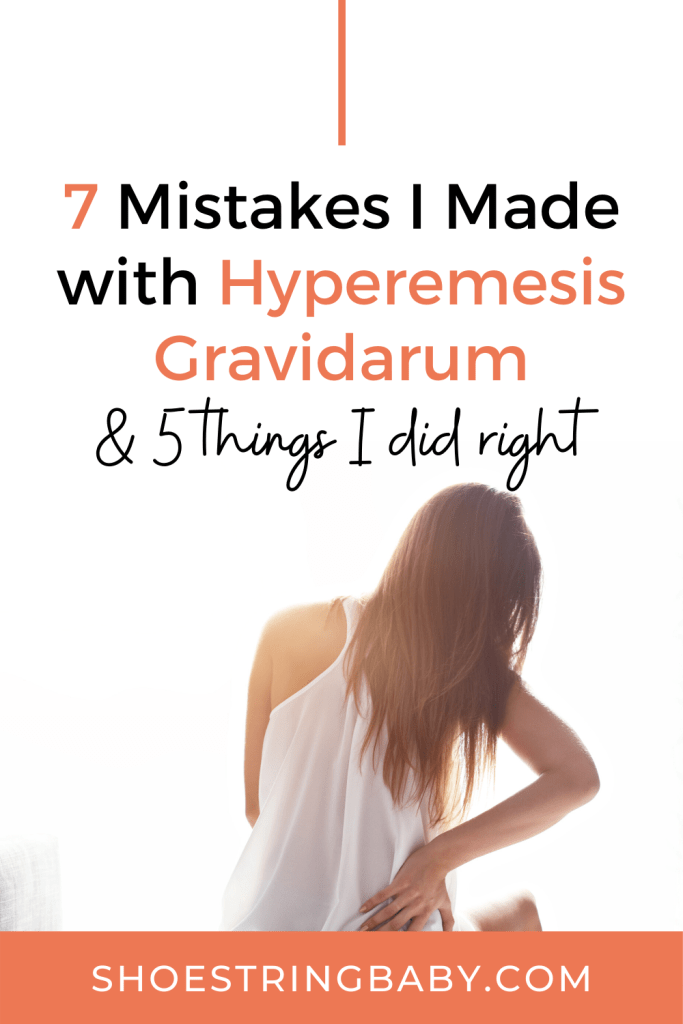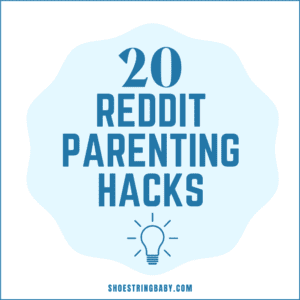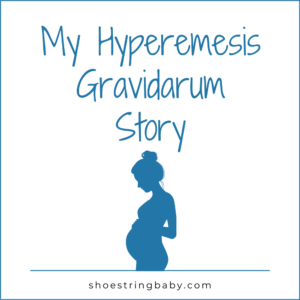7 Things I’d Do Differently with Hyperemesis Gravidarum
This post may contains affiliate links. As an Amazon Associate, I earn from qualifying purchases. Read the full disclosure here.

One of my greatest joys in life is cheap street food when traveling. And admittedly, I’m not as discerning as I should be about food safety when I roll up to a street stand.
I’ve gotten food poisoning way less often than I should have, and honestly, it is has given me a bit of hubris about my iron stomach.
So when I got pregnant last year, morning sickness was pretty much on the bottom of my list of worries.
Alas, my iron stomach was no match for pregnancy hormones and I quickly fell to the mother of all morning sickness: hyperemesis gravidarum.
To say I was underprepared for the severe, unrelenting nausea of hyperemesis is an understatement. I was gobsmacked.
My hyperemesis was most intense in the first half of my pregnancy but I was sick the whole time. I weighed less when I went into labor than when I got pregnant.
You can check out my whole hyperemesis gravidarum story here.
Since I was blindsided by my hyperemesis, there were a lot of things I would do differently if I were to have another hyperemesis pregnancy.
For those who may be dealing with hyperemesis now, here are some of my lessons learned after having hyperemesis:
1. Self-doubt
The number one thing I would change in a future hyperemesis pregnancy is probably also the hardest.
I’d try to doubt myself less.
I wrote about how I was plagued by worries that I was “sick enough” in my hyperemesis story, but it bears repeating here.
Since the severity of hyperemesis varies between pregnancies, it is easy to read other women’s more extreme stories and think that means you can’t also be sick with hyperemesis too.
Just because you’re not the worst case imaginable, doesn’t mean you’re not sick. Hyperemesis can be terrible for all of us, in our own unique ways.
By not fully accepting how sick I was, I didn’t push my doctors for treatments like regular IV fluids that would have helped me.
In a future pregnancy, I’d correct this mistake.
It can be hard enough to get women’s health issues taken seriously (see here and here for two articles on this), so we have to have conviction about our own health.
2. Data collection
I’ve needed to constantly remind myself that my sickness wasn’t just in my head. My staggering weight loss provided concrete evidence of my sickness. I’ve always been a quantitative person and the number on the scale was an objective measure to hang my hat on.
However, I didn’t even realize I had lost any weight until towards the end of my first trimester. I don’t regularly weigh myself so I hadn’t been tracking my weight at all.
If I had, I would have recognized the impact of my illness a lot sooner.
In future pregnancies, I would collect data on myself early and often.
Extent of weight loss is often one criteria for getting a hyperemesis diagnosis. It also helps monitor the progression of your disease.
In addition to weight checks, I would also monitor my ketones (an indicator of starvation and dehydration) with at-home test strips from the onset of sickness. I only started them after my hospitalization.
Finally, I would have requested more monitoring of my electrolytes and nutrients. I was found to be anemic in my third trimester and wonder if it could have been caught sooner with more monitoring.

3. Food
Food when you have hyperemesis is, to put it mildly, problematic.
On Zofran, I was actually able to keep down more food than a lot of women with hyperemesis. However, I was still consuming way less than my usual caloric intake, and all food was deeply gross and offensive.
I cycled through safe foods quickly too. If I managed to eat a meal, I’d soon associate it with being sick and it would be dead to me. A handful of foods, like broth, I was able to eat for longer stretches.
By the halfway mark, I settled into about four foods I could reliably eat – vegetarian hot dogs, french fries, soft pretzels and stone fruit. My baby is made of vegetarian hot dogs.
There are a few things I’d do differently regarding food in a subsequent hyperemesis pregnancy.
First, I’d experiment more with protein shakes and meal replacers. Anything sweet upset my stomach so I struggled to find shake options that worked for me.
Only at the end of my pregnancy did I find Perfect Protein bars (peanut butter only) and Trader Joe’s pea protein based shakes that weren’t sweetened. Before another pregnancy, I would experiment with DIY recipes for these type of things so we could more easily adapt to my unpredictable aversions.
Second, I’d be more careful about the food being consumed around me.
My strongest lingering aversions from my hyperemesis are to things my partner cooked or ate while I was sick, as opposed to things I myself ate.
At the time, I didn’t realize his eating habits were being imprinted with my nausea. It is only now that I’m postpartum and think of those foods that my stomach turns.
4. Constipation
Okay, this is going to get a little personal for a minute.
Because we have to talk about pooping. Or the lack thereof, really.
Many pregnant women experience constipation, likely because of the extra hormones and the expanding uterus cramping the digestive track. But constipation is a whole new ballgame with hyperemesis.
And I need you all to know about this, because when I first got my HG diagnosis and meds, no one told me about it.
Since pooping isn’t something you talk about in polite company, I mostly kept the severity of this issue to myself. It was just one more thing to make you feel pretty alone during hyperemesis, you know?
At one point while I was sick, I found an Amy Schumer instagram post about pooping and it made me feel SO seen.
So yea, we’ve got to talk about hyperemesis and pooping, in case I am not the only one feeling isolated in that part of the experience.
Also because I would have been a lot more proactive in getting ahead of the constipation if I fully grasped what I was up against.
First, most of the normal recommendations for regulating bowel movements while pregnant don’t work for the hyperemesis population.
- Drink more fluids? Wouldn’t I love to!
- Eat high fiber foods? Um, eating anything is a struggle, let alone making dietary choices.
- Exercise? Even if I felt well enough to exercise, I was advised not to since my doctor didn’t want me burning any more calories.
So we are already fighting an uphill battle, and then you add Zofran (an antiemetic medicine) in the mix.
Don’t get me wrong, I love Zofran. Zofran saved me from more hospital trips. My baby is made of Zofran.
But Zofran is notoriously constipating.
And prolonged constipation can exacerbate rectal prolapse risk.
I truly think that months of Zofran constipation did more lasting damage to my body than labor and delivery.
I tried a lot of different medications for constipation the first time, but if I were to do hyperemesis again I’d be a lot more aggressive and proactive with stool softeners and laxatives.
Talk to your doctor about what options may work best for you.
Based on my past experience, and in consulting with my pelvic physical therapist, here is what my general plan would be for a future HG pregnancy:
- Preemptively take at least a half a dose of Miralax at least every other day.
- Take Colace daily (I got a big generic bottle at Costco and it was so much cheaper than at the pharmacy).
- Be much more liberal with Senna and Milk of Magnesia. Last time, I only mixed them in when things got really bad.
- Don’t be afraid of glycerin suppositories. I avoided this the first time, and now think that was a mistake.
- Try to find the lowest dose of Zofran possible. My initial dosing of Zofran was fairly high, and while it controlled vomiting, I still felt truly terrible. In hindsight, I should have tested if lower doses would have controlled my puking earlier in my pregnancy. In round 2, I’d ramp up until I found an effective dose for me instead of diving in the deep end first.
- Be vigilant if you have to start an iron supplement (or if iron is in your prenatal vitamin). I made the huge mistake of starting iron while still on Zofran. Since Iron also constipating, it was unbearable for me on top of the Zofran. It is what finally got me to go off Zofran in my third trimester.
5. IV Fluids
This is going to sound counterintuitive, but one of my best days in early pregnancy was the day I was admitted to the hospital.
You wouldn’t think being sick enough to require hospitalization would be looked back upon fondly. Yet, after weeks of being in the throes of hyperemesis, IV fluids and nutrients gave me (temporary) sweet relief.
When I was first diagnosed with hyperemesis, I thought staying out of the hospital was the goal. This was super dumb. IV fluids are amazing and should be readily available for women with hyperemesis.
Even after my great IV fluid experience, I did not think I was sick enough to justify repeat hospitalizations since my vomiting was well managed with Zofran.
At the time, I didn’t realize there were alternative ways to get IV fluids that didn’t require an emergency hospital admittance.
Some hyperemetic women are able to get IV fluids in their own homes with home health care (which sounds amazing), or on an outpatient basis at infusion centers.
If I were to be pregnant again, I would request this type of outpatient IV fluids early and often.
IV fluids briefly made me feel more human again, and I shouldn’t have waited until I was really, really sick to get them.
Related Post: Hyperemesis and Social Distancing
6. Little Hyperemesis Lessons
There were a number of little things that it took me awhile to get the hang of during my hyperemesis:
- TOOTH CARE – I spent a lot of time having to google tooth care during hyperemesis. The takeaways (1) after puking, don’t brush your teeth right away. Rinse with a baking soda solution and brush at least 30 minutes later; and (2) if toothpaste is too strong of taste, brushing with baking soda also works as a stop gap until you’re less gag-y.
- MOUTH TASTE – For the first half of my pregnancy, I had a weird terrible taste in my mouth that no amount of brushing could handle. I’m not sure if this was a side effect of ketosis or the dissolvable Zofran or something else. I asked my doctor and she didn’t have a good answer. Next time, I’d pursue this more because it impacted me feeling okay enough to eat. Honestly, I’m mostly mentioning this one in case someone else has any ideas they can share. It was gross.
- PILLOWS & DROOLING – I did not realize how much I’d drool in pregnancy. All my pillows now have gross stains on them. Before a future pregnancy, I would get protective covers for my pillows.
- VICKS – only towards the end of my pregnancy did I have the good idea to mask cooking smells with Vicks VapoRub under my nose. I imagine this would also work with other fragrances in whatever flavor did not make your stomach flip. In another pregnancy, I’d keep Vicks by my side.
- LABOR & DELIVERY ADMITTANCES – they usually don’t let you eat if you get admitted to labor and delivery. I made the mistake of not eating sufficiently before going in once. When I finally was released and could eat again, it was the sickest I had been in the latter part of my pregnancy. On future trips, I snacked on the way to the hospital, and requested antacids while admitted.
7. Hyperemesis Recovery
One of my biggest hyperemesis regrets was not asking more questions about the recovery process. As I shared in my hyperemesis story, I was caught off guard by how long my hyperemesis postpartum recovery has lasted.
No one mentioned hyperemesis recovery at my six week postpartum appointment. I independently sought out physical therapy and assumed eating like I did before pregnancy would get me back into shape.
Then I crashed and burned when I tried to do too much (going back to work part-time) at three months postpartum.
Only then did I seek out my regular GYN for help, thinking I had postpartum depression (I had been seeing a high-risk O.B. while I was pregnant).
She was the first person to mention the challenging, extended recovery associated with prolonged starvation.
To her, even a regular pregnancy takes months to recover from (perhaps as many months as you were pregnant), so a complicated pregnancy and/or a pregnancy with starvation is, of course, going to take a lot longer.
She advised me to increase my calories as much as possible, is following me with extensive blood work, and referred me to a nutritionist (I’m still in the process of some of these steps because of the pandemic).
I wish I had realized all of this sooner. Knowing that hyperemesis moms are more at risk for postpartum mental health challenges, I had been vigilant and truly thought I was handling processing the hard pregnancy really well.
In a future hyperemesis pregnancy, I’d better acknowledge that hyperemesis is a traumatic experience, mentally and physically. I’d give myself a lot more time to recovery (for reference, I’m currently 7 months postpartum and don’t feel recovered yet).
I’d also push my O.B. more for better monitoring of my physical recovery.
It’s upsetting that I was set free after my baby was born, without any guidance even though I was clearly depleted and unwell. I hope sharing this will help someone else not be taken aback by the drawn out recovery.
Conclusion: What I did right during my hyperemesis
There are also some things I’m very glad I did during my first round of hyperemesis that I want to mention:
- SEEK HELP EARLY – this was the most important thing I did all pregnancy. I wasn’t even thinking about hyperemesis at the time. I just felt so terrible and needed help to function. It would have been so much worse if I hadn’t started prescription medications (love you, Zofran) so early.
- MEDICATE – this is a personal decision, but for me, I needed medicine to make it through my hyperemesis. From my reading of the literature, the risks of malnutrition and dehydration for the fetus outweighed the risks of the medicines I took. Plus, taking unisom (a sleep aid that helps nausea) every night gave me some of the best sleep of my life.
- SKIP BELOVED FOODS – there were a couple of my favorite foods that I wouldn’t eat while sick because I feared having an aversion to them later. I probably could have eaten avocados or injera, but some things are too precious to lose. While my doctor who very much wanted me to gain weight probably disagrees, I’m thankful for my foresight on this one.
- PHYSICAL THERAPY – I scheduled an appointment with physical therapy for the day after my six-week postpartum appointment. I had been laid up eight months and knew I needed help getting safely back to activity. If my cervix had been more competent, I would have done physical therapy during pregnancy too but that wasn’t in the cards for me.
- TALK ABOUT HYPEREMESIS – I have been very open about being sick in pregnancy and postpartum. We don’t talk about pregnancy complications enough so I’ve gotten pretty fire and brimstone on my awareness campaign. A good chunk of our birth announcement highlighted how women’s health issues like hyperemesis are under-acknowledged, under-researched, and under-funded – and I’m really proud of it.
Looking for more information on hyperemesis? The HER Hyperemesis Education and Research Foundation has a great website. I also spent a lot of time on their instagram (@hgmoms) while I was sick because they share a lot of other women’s stories, which helped me feel less alone in my sickness.
What would you do differently going into a subsequent pregnancy?
Like this post? Pin it!






